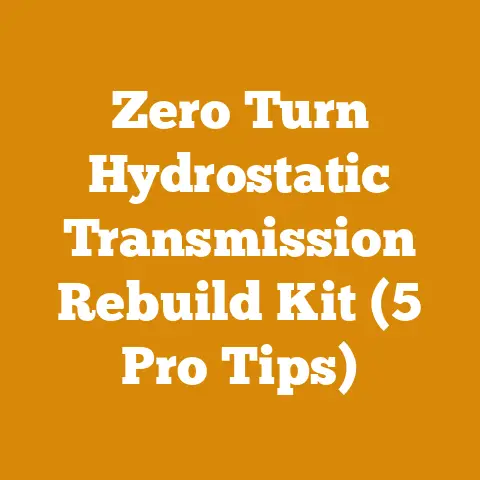Tree Stump Grinding Removal (3 Pro Cleanup Tips for Pros)
Introduction: Breathing Easier – Why Stump Removal Matters More Than You Think
Let’s talk tree stumps. Those stubborn remnants of felled giants can be more than just an eyesore in your yard. They’re a breeding ground for pests, a tripping hazard, and a constant reminder of a tree that’s no longer there. But beyond the aesthetic and practical annoyances, there’s a real health reason to consider stump removal: mold and fungi.
I’ve seen firsthand the impact of decaying wood on air quality, especially in damp environments. Mold spores released from a rotting stump can trigger allergies, asthma, and other respiratory issues. If you’re like me, you value fresh air and a healthy living space. That’s why I’m passionate about sharing the best practices for tree stump grinding and removal – not just for a beautiful yard, but for a healthier life.
In this guide, I’ll walk you through professional cleanup tips that will help you tackle even the most challenging stumps. We’ll delve into the tools, techniques, and strategies that the pros use to get the job done efficiently, safely, and effectively. Buckle up, because we’re about to dive deep into the world of stump grinding!
Tree Stump Grinding Removal (3 Pro Cleanup Tips for Pros)
1. Assessing the Battlefield: Stump Identification and Site Preparation
Before you even think about firing up a stump grinder, you need to understand what you’re up against. Not all stumps are created equal. The species of tree, the size of the stump, and the surrounding environment all play a crucial role in determining the best removal strategy.
Know Your Enemy: Identifying the Tree Species
Why does knowing the tree species matter? Different wood types have different densities and decay rates. For example, a pine stump will generally be easier to grind than an oak stump due to the softer wood. Understanding the wood’s characteristics helps you select the right grinder and adjust your grinding technique.
- Softwoods (Pine, Fir, Spruce): These are generally easier to grind due to their lower density. They also tend to decay faster, making them less resistant in the long run.
- Hardwoods (Oak, Maple, Hickory): These are much denser and more resistant to decay. Grinding hardwood stumps requires more power and patience.
My Personal Experience: I once tackled a massive oak stump that had been sitting for years. The wood was incredibly dense, and my initial grinder struggled to make any progress. I ended up renting a larger, more powerful machine specifically designed for hardwoods. Lesson learned: always assess the wood type before you start grinding!
Site Preparation: Clearing the Area
Before you start grinding, you need to clear the area around the stump. This involves removing any rocks, roots, debris, or other obstacles that could damage the grinder or pose a safety hazard.
- Remove Rocks and Debris: Even small rocks can damage the grinder teeth and send projectiles flying.
- Cut Back Roots: Expose and cut back any large roots extending from the stump. This will make grinding easier and prevent the grinder from getting stuck. I usually use a mattock or axe for this.
- Mark Underground Utilities: This is absolutely critical! Contact your local utility companies to mark any underground lines before you start digging or grinding. Hitting a gas or electrical line can have catastrophic consequences.
- Clear a Safe Zone: Establish a clear zone around the stump to protect yourself and others from flying debris. This zone should be at least 50 feet in all directions.
Data Point: According to the Common Ground Alliance, damage to underground utilities occurs every six minutes in the United States. Always call before you dig!
2. Mastering the Grinding Process: Techniques and Tool Selection
Now for the fun part: grinding that stump into oblivion! This is where your technique and tool selection really come into play.
Choosing the Right Stump Grinder
Stump grinders come in various sizes and power levels. The right grinder for you will depend on the size and type of stumps you’re dealing with, as well as your budget and experience level.
- Small Stump Grinders (Walk-Behind): These are ideal for smaller stumps (less than 12 inches in diameter) and are relatively easy to maneuver.
- Medium Stump Grinders (Self-Propelled): These offer more power and are better suited for medium-sized stumps (12-24 inches in diameter).
- Large Stump Grinders (Tow-Behind): These are the heavy hitters, designed for large stumps (over 24 inches in diameter) and require a truck or tractor for transport.
- Handheld Grinders: These are best for small roots and hard-to-reach areas.
Data Point: Stump grinder rental prices typically range from $100 to $500 per day, depending on the size and type of machine.
Grinding Techniques: The Art of Destruction
The key to effective stump grinding is to use a systematic approach. Here’s the technique I’ve honed over the years:
- Start at the Top: Begin grinding at the top of the stump, working your way down in a sweeping motion.
- Overlap Your Passes: Overlap each pass by a few inches to ensure that you’re grinding the entire surface evenly.
- Grind Below Ground Level: Grind the stump down to at least 6 inches below ground level. This will allow you to backfill the hole with soil and plant grass or other vegetation. I prefer to grind down 12″ or more to allow for optimal replanting.
- Work in Layers: Don’t try to grind too much at once. Take small bites and work in layers to avoid bogging down the grinder.
- Keep the Teeth Sharp: Sharp grinder teeth are essential for efficient grinding. Inspect the teeth regularly and sharpen or replace them as needed. I use a diamond grinding wheel to sharpen my teeth.
- Safety First: Always wear safety glasses, hearing protection, and gloves when operating a stump grinder. Be aware of your surroundings and keep bystanders at a safe distance.
My Personal Experience: I once tried to rush the grinding process by taking too big of bites. The grinder bogged down, the engine stalled, and I ended up spending more time trying to restart the machine than actually grinding the stump. Lesson learned: patience is key!
Wood Species and Grinding Techniques
- Oak: Grind slowly and steadily. Avoid excessive pressure, which can cause the grinder to overheat.
- Pine: Grind in layers to avoid clogging the grinder with resinous wood chips.
- Maple: Grind carefully around the roots, as they can be quite extensive.
Case Study: The Giant Redwood Stump
I was once hired to remove a massive redwood stump from a client’s property. The stump was over 6 feet in diameter and had a complex root system. I knew that a small walk-behind grinder wouldn’t cut it. I rented a large tow-behind grinder and spent two full days grinding the stump down to the required depth. It was a challenging job, but the results were worth it. The client was thrilled to have their yard back!
Equipment Used:
- Large tow-behind stump grinder
- Chainsaw
- Mattock
- Shovels
- Safety glasses
- Hearing protection
- Gloves
Wood Type: Redwood
Safety Considerations:
- The redwood stump was located near a fence, so I had to be careful not to damage it with the grinder.
- The stump was also located on a slope, so I had to take extra precautions to prevent the grinder from tipping over.
3. The Grand Finale: Stump Hole Cleanup and Restoration
Grinding the stump is only half the battle. Once the stump is gone, you need to clean up the mess and restore the area to its former glory.
Removing the Grindings
After grinding, you’ll be left with a pile of wood chips and soil. The easiest way to remove these grindings is to use a shovel and wheelbarrow. You can also use a skid steer loader or other heavy equipment if you have a large area to clean up.
Disposing of the Grindings
There are several ways to dispose of the grindings:
- Composting: Wood chips make excellent compost. Mix them with other organic materials, such as leaves and grass clippings, to create a nutrient-rich soil amendment.
- Mulching: Use the wood chips as mulch around trees and shrubs. Mulch helps to retain moisture, suppress weeds, and regulate soil temperature.
- Landfill: You can also dispose of the grindings at a local landfill. However, this is the least environmentally friendly option.
- Fill the Hole: If you are replanting, the wood chips make a great base for the hole.
Backfilling the Hole
Once you’ve removed the grindings, you need to backfill the hole with soil. Use a mixture of topsoil and compost to create a fertile growing medium.
Replanting and Landscaping
After backfilling the hole, you can replant the area with grass, flowers, or other vegetation. Choose plants that are well-suited to the soil and sunlight conditions. You may need to amend the soil with fertilizer or other nutrients to ensure healthy growth.
Data Point: According to the National Gardening Association, Americans spend over $40 billion on lawn and garden care each year.
Long-Term Maintenance
After replanting, it’s important to maintain the area to prevent weeds and ensure healthy growth. Water the plants regularly, fertilize as needed, and remove any weeds that appear.
My Personal Experience: I once backfilled a stump hole with soil that was too compacted. The grass struggled to grow, and the area looked bare and unsightly. I ended up having to dig up the soil and amend it with compost and other organic materials. Lesson learned: use good quality soil and don’t compact it too much!
Dealing with Sprout Growth
Even after grinding a stump, it’s possible for new sprouts to emerge from the remaining roots. To prevent this, you can apply a herbicide to the cut surface of the roots. Be sure to follow the manufacturer’s instructions carefully.
Alternative Stump Removal Methods
While stump grinding is the most common method of stump removal, there are other options available:
- Chemical Removal: This involves applying a chemical stump remover to the stump. The chemical will gradually decompose the wood, making it easier to remove. This method can take several months to work.
- Burning: In some areas, it may be possible to burn the stump. However, this method is not allowed in all locations due to air quality regulations.
- Manual Removal: This involves digging around the stump and cutting the roots. This method is labor-intensive and is only practical for small stumps.
Conclusion: From Eyesore to Opportunity
Removing tree stumps is more than just a cosmetic improvement. It’s an investment in your property’s value, safety, and overall health. By following these pro cleanup tips, you can tackle even the most challenging stumps and transform your yard into a beautiful and functional space.
Remember, safety is always paramount. Always wear appropriate safety gear and follow the manufacturer’s instructions when operating any power equipment. And if you’re not comfortable tackling the job yourself, don’t hesitate to hire a professional tree service.
So, grab your grinder, put on your safety glasses, and get ready to say goodbye to those unsightly stumps! Your yard – and your lungs – will thank you for it.
Key Takeaways:
- Identify the tree species to determine the best grinding technique.
- Clear the area and mark underground utilities before you start grinding.
- Choose the right stump grinder for the size and type of stumps you’re dealing with.
- Use a systematic grinding approach and work in layers.
- Remove the grindings and backfill the hole with good quality soil.
- Maintain the area to prevent weeds and ensure healthy growth.
- Prioritize safety at all times.
Now get out there and make those stumps disappear! Let me know how it goes!






